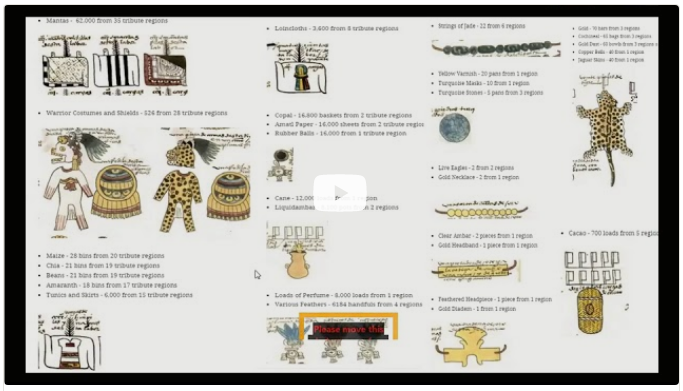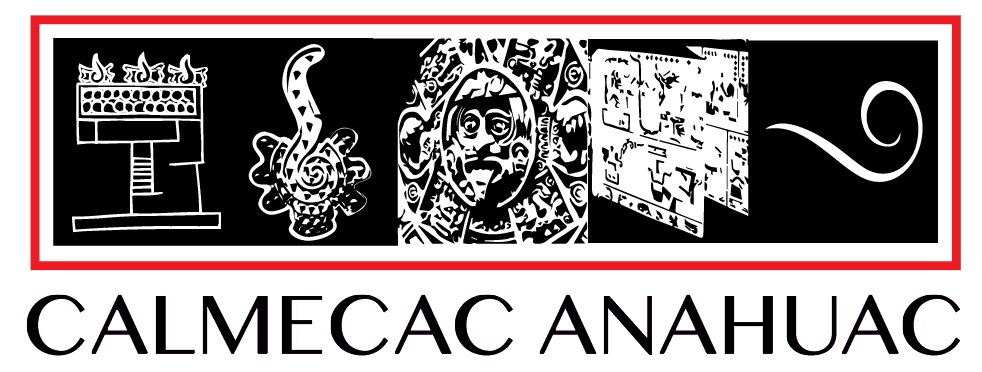
and how it taught us about the Mexica economy, Mexica math,
and Mexica writing!
https://www.patreon.com/posts/lesson-4-de-los-42463165?utm_medium=clipboard_copy&utm_source=copy_to_clipboard&utm_campaign=postshare
Introduction
In this post I will discuss the most important products in Tenochtitlan at the time of the Spanish Conquest. To determine this list I utilized the Codex Mendoza. After the conquest the first thing Hernan Cortez did was asked for a copy of the tribute coming into Tenochtitlan. He was provided with a list copied from Pre-Columbian sources now called the Matricula de los Tributos. Nahua scribes then copied the contents of the Matricula de los Tributos to the Codex Mendoza. The Codex Mendoza contains tribute lists from all of the 37 provinces that were conquered by Tenochtitlan. The frequency of tribute varied between every 80 days to once a year.
The List
This list was difficult to compile because it forced me to define which products were “important,” not an easy task. At first I thought I would go by quantity but that didn’t work because some items such as beans were not necessarily counted by the bean but by the bin whereas other items such as mantas were counted by the manta which inflates the importance of manta. The system I chose then is based on quantity (taking into account different container sizes) plus the number of times the object was requested. Lastly, there were really important products (such as cacao) that the Mexica simply did not have access to because the regions in which these products could be found were not conquered yet.
- Mantas – 62,000 from 35 tribute regions

- Warrior Costumes and Shields – 526 from 28 tribute regions

- Maize – 28 bins from 20 tribute regions
- Chia – 21 bins from 19 tribute regions
- Beans – 21 bins from 19 tribute regions
- Amaranth – 18 bins from 17 tribute regions
- Tunics and Skirts – 6,000 from 15 tribute regions

- Loincloths – 3,600 from 8 tribute regions

- Copal – 16,800 baskets from 2 tribute regions
- Amatl Paper – 16,000 sheets from 2 tribute regions
- Rubber Balls – 16,000 from 1 tribute region

- Cane – 12,000 loads from 1 region
- Liquidambar – 8,100 pots from 2 regions

- Loads of Perfume – 8,000 loads from 1 region
- Various Feathers – 6184 handfuls from 4 regions

- Gourd Bowls – 6,000 from 4 regions
- Lime – 4,400 loads from 2 regions
- Petate Mats – 4,000 from 1 region
- Seats with Backs – 4,000 from 1 region
- Cotton – 4,000 loads from 4 regions
- Quetzal Feathers – 2001 handfuls from 4 regions

- Salt – 2,000 loaves from 1 region
- Chiles – 1,600 loads of chiles from 3 regions

- Wooden Planks – 1,200 pieces from 1 region
- Firewood – 1,200 pieces from 1 region
- Wooden Beams – 1,200 pieces from 1 region
- Wooden Pillars – 1,200 pieces from 1 region
- Deerskins – 800 from 1 region
- Red Seashells – 800 from 1 region
- Maguey Honey – 800 jars from 2 regions
- Bee Honey – 700 jars from 5 regions

- Cacao – 700 loads from 5 regions

- Carrying Frames – 200 from 1 region
- Copper Axes – 180 from 2 regions

- Lip Plugs – 82 from 3 regions

- Gold – 70 bars from 3 regions
- Cochineal – 65 bags from 3 regions
- Gold Dust – 60 bowls from 3 regions
- Copper Bells – 40 from 1 region
- Jaguar Skins – 40 from 1 region

- Strings of Jade – 22 from 6 regions

- Yellow Varnish – 20 pans from 1 region
- Turquoise Masks – 10 from 1 region
- Turquoise Stones – 5 pans from 3 regions

- Live Eagles – 2 from 2 regions
- Gold Necklace – 2 from 1 region

- Clear Ambar – 2 pieces from 1 region
- Gold Headband – 1 piece from 1 region

- Feathered Headpiece – 1 piece from 1 region
- Gold Diadem – 1 from 1 region

Summary
Based on this tribute list, it’s very clear that the Mexica valued manufactured products and food above all the other products. With approximately 200,000 inhabitants living in Tenochtitlan at the time of the conquest, it was very important that they were clothed and fed. Because these items came from many different regions it can be inferred that the clothes and foods were very similar throughout Mexico. Other items were clearly more scarce and were limited to specific regions. Without a doubt if the Spaniards would have never invaded, the Mexica would have continued their territorial expansion further south to acquire more sources for highly prized items such as cacao and quetzal feathers.
The complete Codex Mendoza (pdf) can be found here.

